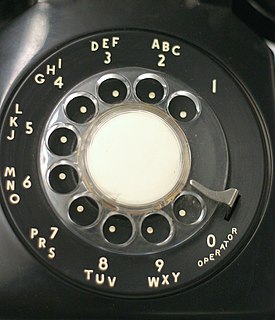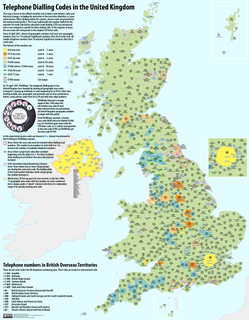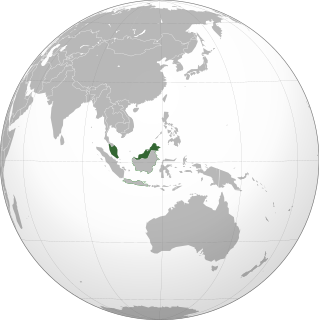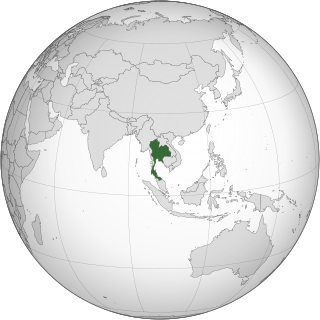
A rotary dial is a component of a telephone or a telephone switchboard that implements a signaling technology in telecommunications known as pulse dialing. It is used when initiating a telephone call to transmit the destination telephone number to a telephone exchange.

The North American Numbering Plan (NANP) is a telephone numbering plan for twenty-five regions in twenty countries, primarily in North America and the Caribbean. This group is historically known as World Zone 1 and has the international calling code 1. Some North American countries, most notably Mexico, do not participate in the NANP.
A toll-free telephone number or freephone number is a telephone number that is billed for all arriving calls instead of incurring charges to the originating telephone subscriber. For the calling party, a call to a toll-free number from a landline is free of charge.
A telephone numbering plan is a type of numbering scheme used in telecommunication to assign telephone numbers to subscriber telephones or other telephony endpoints. Telephone numbers are the addresses of participants in a telephone network, reachable by a system of destination code routing. Telephone numbering plans are defined in each of the administrative regions of the public switched telephone network (PSTN) and in private telephone networks.

Telephone numbers in the United Kingdom are administered by the Office of Communications (Ofcom). For this purpose, Ofcom established a telephone numbering plan, known as the National Telephone Numbering Plan, which is the system for assigning telephone numbers to subscriber stations.
Seven-digit dialing is a telephone dialing procedure customary in some territories of the North American Numbering Plan (NANP) for dialing telephone numbers in the same numbering plan area (NPA). NANP telephone numbers consist of ten digits, of which the leading three are the area code. In seven-digit dialing it is not necessary to dial the area code. The procedure is also sometimes known as local format or network format.
In Argentina, area codes are two, three, or four digits long. Local customer numbers are six to eight figures long. The total number of digits is ten, for example, phone number (11) 1234-5678 for Buenos Aires is made up of a 2-digit area code number and an 8-digit subscriber's number, while (383) 123-4567 would be an example of a Catamarca number.

A telephone exchange name or central office name was a distinguishing and memorable name assigned to a central office. It identified the switching system to which a telephone was connected, and facilitated the connection of telephone calls between switching systems in different localities.

Numbers on the Irish telephone numbering plan are regulated and assigned to operators by ComReg.

Telephone numbers in Singapore, also known as the National Numbering Plan, are regulated by the Info-communications Media Development Authority (IMDA). Due to the small geographical size of Singapore, there are no area or trunk codes; all numbers belong to one numbering area, and thus come in the same 8-digit format. Numbers are categorised based on the first digit, thus providing ten possible categories, of which six are currently in use and the remaining four reserved for future usage.
The expansion of the North American Numbering Plan (NANP) is an anticipated requirement to provide more telephone numbers to accommodate future needs beyond the pool of ten-digit telephone numbers in use since the inception of the NANP in 1947. An October 2020 analysis estimated that the current numbering plan would not be exhausted until after the year 2050.

Telephone numbers in Europe are managed by the national telecommunications authorities of each country. The country calling codes start primarily with 3 and 4, however, some countries that by the Copenhagen criteria are considered part of Europe have country codes from the Asia range, starting with 9.

Telephone numbers in Malaysia are regulated by the Malaysian Communications and Multimedia Commission (MCMC).

The regulation of telephone numbers in Germany is the responsibility of the Federal Network Agency of the German government. The agency has a mandate to telecommunications in Germany and other infrastructure systems.

Thailand's telephone numbering plan in Thailand is managed by the National Broadcasting and Telecommunications Commission (NBTC) in accordance with International Telecommunication Union's (ITU) recommendation E.164.

Telephone numbers in India are administered under the National Numbering Plan of 2003 by the Department of Telecommunications of the Government of India. The numbering plan was last updated in 2015. The country code "91" was assigned to India by the International Telecommunication Union in the 1960s.
Speed dial is a function available on many telephone systems allowing the user to place a call by pressing a reduced number of keys. This function is particularly useful for phone users who dial certain numbers on a regular basis.
National conventions for writing telephone numbers vary by country. While international standards exist in the form of recommendation E.123 by the sector ITU-T of the International Telecommunication Union (ITU), national telephone numbering plans define the format of telephone numbers assigned to telephones and similar communication endpoints.

A telephone number is a sequence of digits assigned to a landline telephone subscriber station connected to a telephone line or to a wireless electronic telephony device, such as a radio telephone or a mobile telephone, or to other devices for data transmission via the public switched telephone network (PSTN) or other public and private networks.
The original North American area codes were established by the American Telephone & Telegraph Company (AT&T) in the years immediately following World War II. Creating a comprehensive and universal, continent-wide telephone numbering plan was a basic requirement for nationwide Operator Toll Dialing which had the goal of speeding the connecting times for long-distance calling by eliminating intermediary telephone operators. It had the eventual benefit of direct distance dialing (DDD) by telephone subscribers. It established a uniform destination addressing and call routing system for all telephone networks in North America that had become an essential public service.











